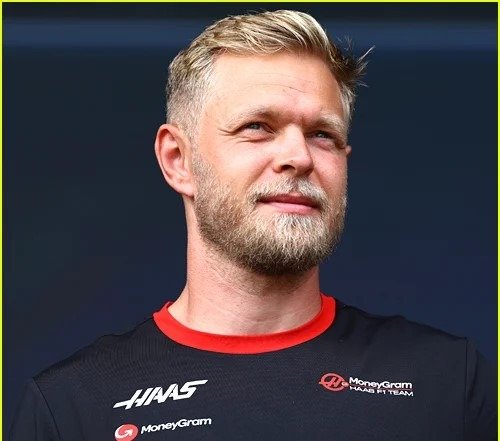Kevin Magnussen’s projected $30 million net worth is a testament to a career marked by perseverance, flexibility, and the will to keep going when things went terribly wrong. His ascent through the Formula 1 ranks has been both unpredictable and inspirational, demonstrating that hard work can be just as effective as natural skill.

Kevin’s father, Jan Magnussen, a former Formula 1 driver and four-time Le Mans class winner, instilled his love of racing in him. He was born in Roskilde, Denmark. It was an exhilarating and ambitious upbringing. Kevin demonstrated a natural accuracy that suggested his future success when he was just two years old and was already controlling a go-kart. Kevin learned early on that motorsport rewards patience just as much as speed, and under Jan’s guidance, he developed the discipline to strive for perfection.
Kevin Magnussen – Personal and Professional Profile
| Full Name | Kevin Jan Magnussen |
|---|---|
| Date of Birth | October 5, 1992 |
| Birthplace | Roskilde, Denmark |
| Nationality | Danish |
| Profession | Formula 1 Racing Driver |
| Teams | McLaren, Renault, Haas |
| Net Worth (2025) | $30 Million (Approx. £24 Million) |
| Height | 1.74 m (5 ft 8 in) |
| Father | Jan Magnussen (Former F1 Driver) |
| Mother | Britt Petersen |
| Wife | Louise Gjørup (Married 2019) |
| Children | Two daughters – Laura and Agnes |
| Reference |
Kevin Magnussen’s racing career has been especially exciting over the last ten years, marked by triumphs, disappointments, and comebacks that have almost appeared like scenes from a movie. When McLaren gave him his Formula 1 debut in 2014, it was his first significant breakthrough. Following Daniel Ricciardo’s disqualification, he finished on the podium in Melbourne in his maiden race, which was nothing short of amazing and immediately established him as one of the most talented young drivers on the grid.
But Formula 1 triumph is frequently short-lived. On his 23rd birthday in 2015, McLaren sent him an email informing him that he had been demoted to a reserve driver position. Although many might have been devastated by the incident, Magnussen saw it as a lesson in perseverance. His later tenure with Renault and Haas, where he demonstrated that consistency and mental toughness could be just as vital as the fastest car, were especially noteworthy for his determination.
Magnussen changed the course of his career with calculated choices and unwavering determination. After working for McLaren and Renault, he joined Haas in 2017 and helped the American-owned team become a serious contender. His relationship with the team was very effective; engineers and fans alike were pleased by his keen criticism, diligent work ethic, and capacity to get performance out of a challenging car.
Many believed that Magnussen’s F1 career came to an end when Haas had financial difficulties in 2020 and let him leave. However, in a very surprising turn of events, Kevin switched to endurance racing and joined Cadillac Chip Ganassi Racing in the DPi class of the IMSA. The maneuver showed off his extremely broad skill set and his love of racing in all its forms. Later on, he acknowledged that racing outside of Formula 1 was “liberating,” allowing him to rediscover the joy of driving without the pressure of a corporation.
Then the phone call arrived, which once more altered everything. Haas desperately needed an experienced driver in early 2022 after Nikita Mazepin abruptly left, and Magnussen was the ideal candidate. His comeback to Formula 1 was incredibly successful. He outperformed colleague Mick Schumacher during his comeback season, showed his tenacity to fans, and earned Haas his first-ever pole position at the São Paulo Grand Prix. One of the season’s most notable incidents was the ensuing emotional and incredulous radio call.
However, the Formula 1 industry doesn’t take many breaks. With the addition of Nico Hülkenberg as a teammate in 2023, Magnussen’s challenge become more difficult. Even though he kept fighting hard, the organization started to focus on younger players, finally acquiring Oliver Bearman and Esteban Ocon for 2025. Despite this, Kevin’s reputation as a driver who never gave up, no matter how difficult the road ahead, remained remarkably resilient.
That same tenacity is shown in his financial journey. Magnussen has made millions of dollars via endorsements, racing contracts, and incentives throughout the years. In addition to sponsorships from companies like Jack & Jones, his agreements with Haas and Renault were especially advantageous. Earnings from endurance racing and personal endeavors are also included in his net worth, demonstrating his commendable career management.
Kevin’s hectic life is made more comfortable by his family. The couple has been married since 2019 and has a very discreet personal life. Often spotted at racing weekends, Louise, a Danish graduate with a degree in biology and sports, quietly backs her husband. Laura, born in 2021, and Agnes, born in 2023, are their two daughters together. Being a father gave Kevin a new perspective on life, bringing him emotionally grounded and changing the way he handles the demanding demands of racing.
Kevin’s career story is also still shaped by his relationship with his father, Jan. A particularly poignant moment occurred when the two generations shared the same cockpit and were motivated by the same enthusiasm during their joint participation in the 2021 24 Hours of Le Mans. Fans were reminded by the experience that motorsport is fundamentally human despite its numbers and sponsorships.
Over the years, Magnussen’s racing career has resembled those of more seasoned drivers like Nico Hülkenberg and Fernando Alonso, who overcame professional setbacks to emerge stronger. Their tales, like Kevin’s, demonstrate the timeless value of experience in a sport that is becoming more and more dominated by young people. Magnussen demonstrated that maturity and instinct may trump raw pace in pivotal situations by retaining emotional equilibrium and physical acuity.
His career serves as an example of how flexibility fosters longevity, both financially and professionally. Magnussen considerably lessened the financial instability that many drivers experience after Formula 1 by exhibiting disciplined performance and being receptive to different racing disciplines. His projected $30 million fortune is the consequence of a career based on perseverance, flexibility, and the capacity to stay relevant rather than just contracts.
Magnussen’s story has social resonance because it reflects more general concepts of tenacity and creativity. His journey serves as a reminder that success frequently results from persevering in showing up even when the ovation subsides, reflecting a societal admiration for people who bounce back stronger after rejection.
The competitive instability in Formula 1 and Haas’s fluctuating lineup in previous seasons have highlighted how quickly things can change. Kevin Magnussen, however, maintained an exceptionally high level of composure throughout it all—calm in loss, thankful in triumph, and acutely self-aware. Younger drivers are still motivated by his narrative because they see in him a model for perseverance in the face of uncertainty.
In 2025, Kevin might pursue endurance racing or perhaps serve as a mentor for up-and-coming drivers. He is extremely valuable outside of the driver’s seat due to his experience, which has been honed by years of intense racing. His next chapter will probably have just as much of an impact as the one he just finished, regardless of whether he choose to race or mentor others.
